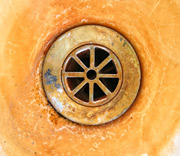
- The TRUTH About America's Water
- Water Pollutants that Cause Illness
- Are Minerals in Water Important for Health?
- Top 5 Drinking Water Contaminants
- Do I Need a Whole House Water Filter?
Water Problems - Iron
"Iron water" readily stains plumbing fixtures, porcelain, and cooking utensils. When used in the laundry, it soon stains washables with reddish-brown discolorations. "Iron water" also leaves its telltale marks on walls and floors if used in doing home cleaning chores.

Iron water, if not treated, can lead to serious complications in many industrial applications. In fact, there is hardly any wet process work that can be carried on successfully with water that contains iron.
Iron imparts a disagreeable metallic taste to water. Even when water contains small amounts of iron a disagreeable, somewhat astringent quality is apparent. Naturally, when the iron is present in detectable amounts, it can ruin the flavor of tea, coffee, and alcoholic beverages. Further, the combination of soluble iron and certain of the constituents in the beverages gives them an unappetizing, inky black appearance.
The EPA Secondary Drinking Water Regulations recommend a maximum of 0.3 milligrams per liter (ppm) iron, like Fe, and a maximum of 0.05 mg/l (ppm) manganese, as Mn, because of the staining that higher concentrations can cause. In its insoluble forms, iron can form deposits in pressure tanks, pipelines, water heaters, commodes, and in any other equipment where water is used.
Iron problems, either alone or in combination with other troublesome water conditions, are frequent due to the fact that about five percent of the earth's crust is made up of iron. Though not found in a pure state, iron ores are abundant and widely distributed over the earth.
Dissolved concentrations of iron in excess of 60 mg/l are known to exist. Usually, however, no more than 5 mg/l of iron is present in a water supply. Unfortunately, iron in water becomes a real source of trouble to the homemaker when as little as 0.3 mg/l is present, generally considered to be the minimum staining level in homes. For many industrial needs, an even more critical tolerance of just 0.1 mg/l is necessary.
Water collects iron in several ways. Even as it falls through the air, the water acquires small amounts of the oxides of iron found in the atmospheric dust. Water, rich in carbon dioxide, readily dissolves iron from the earth's plentiful deposits as it leaches these in its underground flow. This sink shows the results of iron staining. Not an eye-appealing sight! Water containing soluble iron is clear and colorless when drawn into the sink or tub. When it comes into contact with the air, the iron forms a gelatinous precipitate. The stains that result are extremely hard to remove. Witness this ruined your sink or bathtub!





